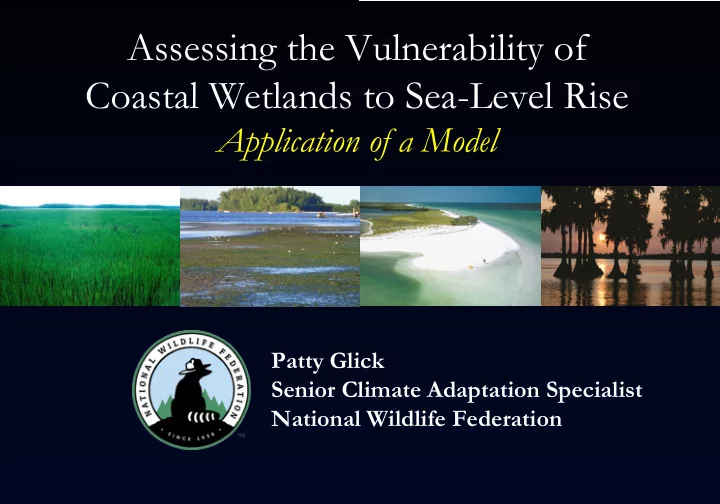

Assessing the Vulnerability of Coastal Wetlands to Sea-Level Rise Application of a Model Patty Glick Senior Climate Adaptation Specialist National Wildlife Federation
Overview of Sea-Level Rise Subsidence, tectonic Ocean circulation patterns, shifts, etc. Earth’s rotation, etc. Input from melting Sediments, marsh Thermal glaciers and ice sheets accretion expansion
Assessing Impacts and Vulnerability Examples of Modeling and Assessment Tools: • “Bathtub” models • Statistical models (e.g., SLAMM) • Multi-disciplinary tools • Expert opinion
What is SLAMM? SLAMM Simulates the Dominant Processes Involved in Wetland Conversions and Shoreline Modifications During Long-Term Sea-Level Rise (e.g., Elevation/tidal range and marsh type) Titus and Wang 2008
Multiple Scenarios, Localized Changes • Accelerating Sea-Level Rise, 25- year Time Steps – Eustatic sea-level rise • Addresses Primary Processes – Inundation, erosion, saturation, overwash, accretion, salinity • Site-Specific Accretion Rates and Geological Factors – Relative sea-level rise
Key Data Inputs • Land Elevation – (e.g., LiDAR) • Tidal Data – (e.g., NOAA tide gauges) • Habitat Coverage – (e.g., FWS NWI, ifSAR, C-CAP) • Other Land Use • Data for Relative Sea-Level Rise
Accretion Data • SLAMM 6 Allows Accretion Feedback – Accretion rates higher in areas of lower elevation – Feedback not used for floating marshes (LA application)
Hindcast and Forecast • Model Validation (Hindcast) – Purpose of this exercise is to run the model, starting at a time in the past (depending on data availability), and examine results against “current” data • Model Calibration (Hindcast) – Start with model validation, examine model parameters and modify them (within feasible range) to gather best possible simulation • Calibrated Model Serves as Basis for Forecasting
Forecast: SLR scenarios
Possible Additional Information Needs • Localized geomorphology, hydrology • Specific impacts on species and ecosystems • Interaction with additional climate and non-climate stressors
For more information about SLAMM • SLAMM Webpage http://warrenpinnacle.com/prof/SLAMM or Google “SLAMM” – Includes Brief Model Overview, Bibliography – Updated with Latest Projects and Results – Technical Documentation with Full Model Specs – Model Executable/Source Code Available through the Forum • Email: jclough@warrenpinnacle.com
Using SLAMM Results Help prioritize species and systems • Identify sites based on ecological/economic importance and vulnerability to sea-level rise
Using SLAMM Results Virginia’s Eastern Shore
Using SLAMM Results Help prioritize species and systems • Identify areas with potential for upland protection (e.g., marginal agricultural land)
Using SLAMM Results Skagit Bay, Washington
Using SLAMM Results Help develop management strategies • Removal of coastal armoring • Purchase of development rights/easements
Using SLAMM Results Nisqually NWR, Washington
Using SLAMM Results Help develop management strategies • Restore/build “protective” habitats such as mangroves and dunes
Using SLAMM Results Charlotte Harbor/Pine Island, Florida
Using SLAMM Results Develop management strategies • Assess potential for “assisted accretion” (e.g., reconnecting to sources of sediment, using dredged materials, etc.)
Using SLAMM Results Help allocate resources efficiently •Identify/support additional research ― Localized geomorphology ― Species-specific impacts ― Interaction with additional stressors
Recommend
More recommend